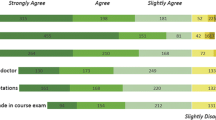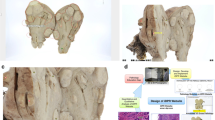Abstract
Since digital microscopy (DM) has become a useful alternative to conventional light microscopy (CLM), several approaches have been used to evaluate students’ performance and perception. This systematic review aimed to integrate data regarding the use of DM for education in human pathology, determining whether this technology can be an adequate learning tool, and an appropriate method to evaluate students’ performance. Following a specific search strategy and eligibility criteria, three electronic databases were searched and several articles were screened. Eight studies involving medical and dental students were included. The test of performance comprised diagnostic and microscopic description, clinical features, differential, and final diagnoses of the specimens. The students’ achievements were equivalent, similar or higher using DM in comparison with CLM in four studies. All publications employed question surveys to assess the students’ perceptions, especially regarding the easiness of equipment use, quality of images, and preference for one method. Seven studies (87.5%) indicated the students’ support of DM as an appropriate method for learning. The quality assessment categorized most studies as having a low bias risk (75%). This study presents the efficacy of DM for human pathology education, although the high heterogeneity of the included articles did not permit outlining a specific method of performance evaluation.


Similar content being viewed by others
References
Boyce BF (2015) Whole slide imaging: uses and limitations for surgical pathology and teaching. Biotech Histochem 90:321–330
Saco A, Bombi JA, Garcia A, Ramírez J, Ordi J (2016) Current status of whole-slide imaging in education. Pathobiology 83:79–88
Merk M, Knuechel R, Perez-Bouza A (2010) Web-based virtual microscopy at the RWTH Aachen University: didactic concept, methods and analysis of acceptance by the students. Ann Anat 192:383–387
Higgins C (2015) Applications and challenges of digital pathology and whole slide imaging. Biotech Histochem 90:341–347
Koch LH, Lampros JN, Delong LK, Chen SC, Woosley JT, Hood AF (2009) Randomized comparison of virtual microscopy and traditional glass microscopy in diagnostic accuracy among dermatology and pathology residents. Hum Pathol 40:662–667
McCready ZR, Jham BC (2013) Dental students’ perceptions of the use of digital microscopy as part of an oral pathology curriculum. J Den Educ. 77:1624–1628
Ariana A, Amin M, Pakneshan S, Dolan-Evans E, Lam AK (2016) Integration of traditional and E-learning methods to improve learning outcomes for dental students in histopathology. J Den Educ. 80:1140–1148
Al-Janabi S, Huisman A, Van Diest PJ (2012) Digital pathology: current status and future perspectives. Histopathology. 61:1–9
Araújo ALD, Amaral-Silva GK, Fonseca FP, Palmier NR, Lopes MA, Speight PM, de Almeida OP, Vargas PA, Santos-Silva AR (2018) Validation of digital microscopy in the histopathological diagnoses of oral diseases. Virchows Arch. 473:321–327
Fónyad L, Gerely L, Cserneky M, Molnár B, Matolcsy A (2010) Shifting gears higher – digital slides in graduate education – 4 years experience at Semmelweis University. Diagn Pathol. 5:73
Szymas J, Lundin M (2011) Five years of experience teaching pathology to dental students using the WebMicroscope. Diagn Pathol. 30:6
Alotaibi O, ALQahtani D (2016) Measuring dental students' preference: a comparison of light microscopy and virtual microscopy as teaching tools in oral histology and pathology. Saudi Dent J 28:169–173
Brierley DJ, Speight PM, Hunter KD, Farthing P (2017) Using virtual microscopy to deliver an integrated oral pathology course for undergraduate dental students. Br Dent J. 223:115–120
Braun MW, Kearns KD (2008) Improved learning efficiency and increased student collaboration through use of virtual microscopy in the teaching of human pathology. Anat Sci Educ 6:240–246
Fonseca FP, Santos-Silva AR, Lopes MA et al (2015) Transition from glass to digital slide microscopy in the teaching of oral pathology in a Brazilian dental school. Med Oral Patol Oral Cir Bucal. 20:e17–e22
Fernandes CIR, Bonan RF, Bonan PRF, Leonel ACLS, Carvalho EJA, de Castro JFL, Perez DEC (2018) Dental students' perceptions and performance in use of conventional and virtual microscopy in oral pathology. J Dent Educ. 82:883–890
Kumar RK, Velan GM, Korell SO, Kandara M, Dee FR, Wakefield D (2004) Virtual microscopy for learning and assessment in pathology. J Pathol. 204:613–618
Ordi O, Bombó JA, Martínez A et al (2015) Virtual microscopy in the undergraduate teaching of pathology. J Pathol Inform. 6:1
Walkowski S, Lundin M, Szymas J, Lundin J (2014) Students’ performance during practical examination on whole slide images using view path tracking. Diagn Pathol. 9:208
Moher D, Liberati A, Tetzlaff J et al (2009) Preferred reporting items for systematic reviews and meta-analyses: the PRISMA statement. Ann Intern Med. 151:264–269
Wilson AB, Taylor MA, Klein BA et al (2016) Meta-analysis and review of learner performance and preference: virtual versus optical microscopy. Med Educ 50:428–440
Kuo KH, Leo JM (2018) Optical versus virtual microscope for medical education: a systematic review. Anat Sci Educ. 12:678–685. https://doi.org/10.1002/ase.1844
Ouzzani M, Hammady H, Fedorowicz Z et al (2016) Rayyan—a web and mobile app for systematic reviews. Syst Ver. 5:210
Moola S, Munn Z, Tufanaru C, Aromataris E, Sears K, Sfetcu R, Currie M, Qureshi R, Mattis P, Lisy K, Mu P-F (2017) Chapter 7: Systematic reviews of etiology and risk. In: Aromataris E, Munn Z (eds) Joanna Briggs Institute Reviewer's Manual. The Joanna Briggs Institute. Available from https://reviewersmanual.joannabriggs.org/
Cochrane Effective Practice and Organisation of Care (EPOC) (2017) EPOC Resources for review authors. https://epoc.cochrane.org/resources/epoc-resources-review-authors. Accessed 6 April 2019
Farah CS, Maybury T (2009) Implementing digital technology to enhance student learning of pathology. Eur J Dent Educ 13:172–178
Brick KE, Sluzevich JC, Cappel MA, DiCaudo DJ, Comfere NI, Wieland CN (2013) Comparison of virtual microscopy and glass slide microscopy among dermatology residents during a simulated in-training examination. J Cutan Pathol 40:807–811
Nauhria S, Ramdass P (2019) Randomized cross-over study and a qualitative analysis comparing virtual microscopy and light microscopy for learning undergraduate histopathology. Indian J Pathol Microbiol. 62:84–90
Holmboe ES, Edgar L, Hamstra S, The Accreditation Council for Graduate Medical Education (ACGME) (2016) The Milestones Guidebook. https://www.acgme.org/Portals/0/MilestonesGuidebook.pdf. Accessed 10 Oct 2019
Hassel LA, Fung KM, Chaser B (2011) Digital slides and ACGME resident competencies in anatomic pathology: An altered paradigm for acquisition and assessment. J Pathol Inform. 2:27
Triola MM, Holloway WJ (2011) Enhanced virtual microscopy for collaborative education. BMC Med Educ. 11:4
Lee LMJ, Goldman HM, Hortsch M (2018) The virtual microscopy database-sharing digital microscope images for research and education. Anat Sci Educ. 11:510–515
Mione S, Valcke M, Cornelissen M (2013) Evaluation of virtual microscopy in medical histology teaching. Anat Sci Educ. 6:307–315
Volynskaya Z, Evans AJ, Asa SL (2017) Clinical applications of whole-slide imaging in anatomic pathology. Adv Anat Pathol. 24:215–221
Leica Biosystems (2020) Scan – Aperio Digital Pathology Slide Scanners. https://www.leicabiosystems.com/digital-pathology/scan/. Accessed 10 July 2020
Olympus Corporation (2019). VS200 Research Slide Scanner. https://www.lri.se/onewebmedia/VS200.pdf. Accessed 10 July 2020
3DHISTECH Ltd. (2020) PANNORAMIC Digital Slide Scanners. https://www.3dhistech.com/products-and-software/hardware/pannoramic-digital-slide-scanners/. Accessed 10 July 2020 .
Hamamatsu photonics (2020) NanoZoomer Series. https://nanozoomer.hamamatsu.com/resources/pdf/sys/SBIS0126E_NanoZoomer_Lineup.pdf. Accessed 10 July 2020
Koninklijke Philips NV (2020) Ultra Fast Scanner - Digital pathology slide scanner. https://www.usa.philips.com/healthcare/product/HCNOCTN442/ultra-fast-scanner-digital-pathology-slide-scanner. Accessed 10 July 2020 .
Zeiss Germany (2020) ZEISS Axio Scan.Z1 - Your Fast and Flexible Slide Scanner for Fluorescence and Brightfield. https://www.zeiss.com/microscopy/int/products/imaging-systems/axio-scan-z1.html. Accessed 10 July 2020
Leica Biosystems (2017) Aperio ImageScope User’s Guide. https://drp8p5tqcb2p5.cloudfront.net/fileadmin/img_uploads/digital_pathology/MAN-0001-Rev-Q.12.4_pdf.pdf. Accessed 10 July 2020
3DHISTECH Ltd. (2018) CaseViewer 2.2 User Guide. https://assets.thermofisher.com/TFS-Assets/APD/Product-Guides/US-Only-CaseViewer-2-2-Win-User-Guide-EN-Rev1.pdf. Accessed 10 July 2020
Hamamatsu photonics (2020) NDP.view2 Instruction manual. https://www.hamamatsu.com/sp/sys/en/manual/NDPview2_manual_en.pdf. Accessed 10 July 2020
Koninklijke Philips NV (2020) Image Management System viewer - Pathology case viewer. https://www.usa.philips.com/healthcare/product/HCNOCTN444/intellisite-pathology-suite. Accessed 10 July 2020
Zeiss Germany (2020) ZEISS ZEN lite - The Perfect Software Solution to Work with Microscope Images in CZI File Format. https://www.zeiss.com/microscopy/int/products/microscope-software/zen-lite.html. Accessed 10 July 2020
Bankhead P, Loughrey MB, Fernández JA, Dombrowski Y, McArt DG, Dunne PD et al (2017, 2017) QuPath: Open source software for digital pathology image analysis. Sci Rep 7(1)
Pathcore (2019) PathcoreSedeen™. https://pathcore.com/sedeen/. Accessed 10 July 2020
Dee FR (2009) Virtual microscopy in pathology education. Hum Pathol. 40:1112–1221
Mirham L, Naugler C, Hayes M et al (2016) Performance of residents using digital images versus glass slides on certification examination in anatomical pathology: a mixed methods pilot study. CMAJ Open. 25:E88–E94
Pantanowitz L, Sinard JH, Henricks WH, Fatheree LA, Carter AB, Contis L, Beckwith BA, Evans AJ, Lal A, Parwani AV, College of American Pathologists Pathology and Laboratory Quality Center (2013) Validating whole slide imaging for diagnostic purposes in pathology: guideline from the College of American Pathologists Pathology and Laboratory Quality Center. Arch Pathol Lab Med. 137:1710–1722
Author information
Authors and Affiliations
Corresponding author
Ethics declarations
Conflict of interest
The authors declare that they have no conflicts of interest.
Ethical responsibilities of author section
All authors contributed significantly to the conception, design, and execution of this study, as well as the retrieval, assessment, and interpretation of results. The draft and the final version of the manuscript was reviewed and approved by all parts. The authors also state that the study is original, has not been published elsewhere, and has been submitted only to the Virchows Archiv.
Additional information
Publisher’s note
Springer Nature remains neutral with regard to jurisdictional claims in published maps and institutional affiliations.
This article is part of the Topical Collection on Quality in Pathology
Electronic supplementary material
Supplementary Table 1.
Methodological features of the articles fully assessed in this study. (XLSX 14 kb)
ESM 1
(DOCX 16 kb)
Rights and permissions
About this article
Cite this article
Rodrigues-Fernandes, C.I., Speight, P.M., Khurram, S.A. et al. The use of digital microscopy as a teaching method for human pathology: a systematic review. Virchows Arch 477, 475–486 (2020). https://doi.org/10.1007/s00428-020-02908-3
Received:
Revised:
Accepted:
Published:
Issue Date:
DOI: https://doi.org/10.1007/s00428-020-02908-3




